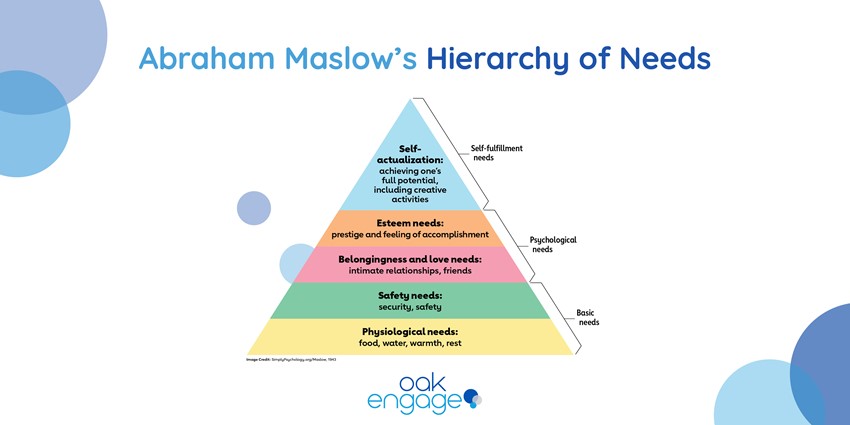Employee engagement is increasingly becoming one of the most important indicators in gauging work satisfaction. Employees today are looking for more than just a 9-to-5 job. They want to be involved in their work, enthusiastic about the organisation they work for and committed to their fellow workers. When employees are engaged, the company is more likely to succeed.
However, we understand that it can be difficult to engage your workforce when you’re unsure of where to start. But don't worry, we’ve got you covered. In this guide we’ll explore everything from the basics to the in-depth issues and importance of employee engagement:
- Employee Engagement Definition
- Why is Employee Engagement Important?
- The Impact of Poor Employee Engagement
- How Engaged are Employees of Today?
- Types of Employee Engagement
- Drivers of Employee Engagement
- Who is Responsible for Employee Engagement?
- Employee Engagement Examples in Action
- Benefits of Employee Engagement
- Reasons for Low Employee Engagement
- How to Improve Employee Engagement
What Is Employee Engagement?
Employee engagement is the emotional commitment the employee has to the organisation and its goals.
This emotional commitment means engaged employees actually care about their work and their company. They don't work just for the pay, but work on behalf of the organization's goals, ultimately creating more success for the company.
Why Is Employee Engagement Important?
Organisations are still continuing to struggle to engage their workforce. Even with 20 plus years of employee engagement awareness, why is this? In July 2017, just 41% of UK employees feel aligned with their organisations’ goals, and 36% of employees are likely to leave their jobs within one year because they’re so engaged.
The benefits of employee engagement simply can’t be overlooked – employee engagement has been proven to:
- Reduce staff turnover
- Improve productivity and efficiency
- Increase employee retention
- Deliver higher profits
- Boost business connectivity and performance
- Reduction in absenteeism

Having an engaged team makes a business easier to run, and enables management to focus on activities that deliver higher value, such as innovation, process improvement and development. In a nutshell, this is why employee engagement is so important to business outcomes and success.
The Impact of Poor Employee Engagement
The number of engaged employees within a business can often be an indicator of success. As of January 2020, 38% of employees are disengaged and 21% of employees are actively disengaged. The number of disengaged employees in a business can highlight serious workplace dysfunction, poor work culture and even a lack of clarity when it comes to roles and skills.
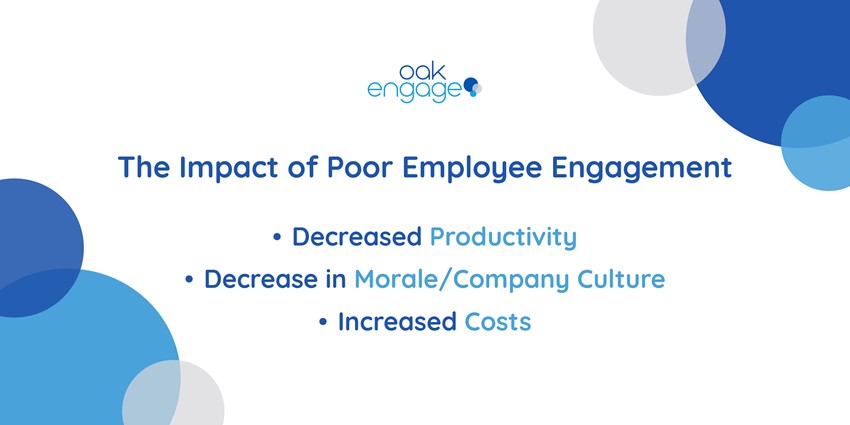
Before we discuss how to improve employee engagement across your workforce, it’s important to know the factors that poor employee engagement can cause:
Decreased Productivity
Poor employee engagement will lead to decreased productivity, meaning it takes employees longer to get a task done. Research shows that disengaged employees are less likely to work hard, feel motivated, or meet expectations for their role, and they cause 60% more errors and defects in work performance. In fact, 73% of actively disengaged employees are on the lookout for new jobs or opportunities.
Decrease in Morale and Company Culture
Company culture and employee engagement have a symbiotic relationship. 75% of employees agree that workplace culture has a direct correlation to their on-the-job engagement. If the culture is encouraging and supportive, employees are likely to feel more engaged. A dysfunctional culture can lead to widespread disengagement, low morale and workplace anxiety.
Increased Costs
Disengaged employees are certainly costly. Not only do they tend to be a drain on a company’s time and resources, but they are also responsible for driving away other engaged employees. Significant costs are used every time you onboard an employee. So if that employee does not stick around for long, your hiring process can become unnecessarily expensive.
To put the problem in perspective, disengaged employees are thought to cost the UK £52 – 70 billion per year in lost productivity.
Failed Company Goals
When employees feel disengaged with the company they work for, they are less likely to see the value in working to meet corporate goals.
71% of senior executives and business leaders believe that employee engagement is integral to achieving organisational success. It’s clear to them that an engaged workforce leads to improved productivity and performance, as well as increased motivation.
How Engaged Are Employees Today
According to Gallup’s State of the Global Workplace, 85% of the global workforce are not engaged at work.
So, what does employee engagement look like here in the UK? Apparently we’re lagging behind most of the world. According to a survey of more than 4,500 workers, the UK recorded an average engagement score of 45%. This score is lower than France (54%), Australia (56%) and the USA (60%).
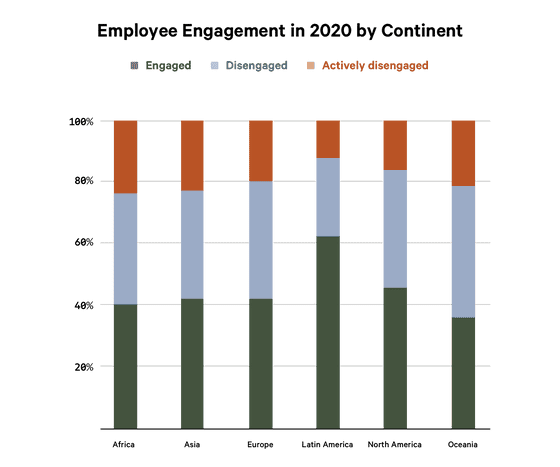
As for the Employee Engagement Data by industry, just 42% of Consumer employees are engaged, 34% of Manufacturing employees are engaged and 41% of Healthcare employees are engaged. So there is still a long way to go to boost those engagement rates across these sectors.
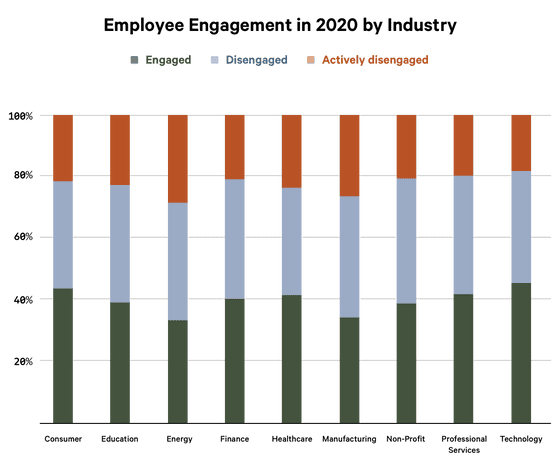
Recommended Reading 📖: 25 Employee Engagement Statistics You Wouldn't Believe
Types of Employee Engagement
There are 3 types of employee engagement. Once you know what they are, it will help your company to better understand the attitudes and performance levels of your employees and what you can do to improve engagement across the business.
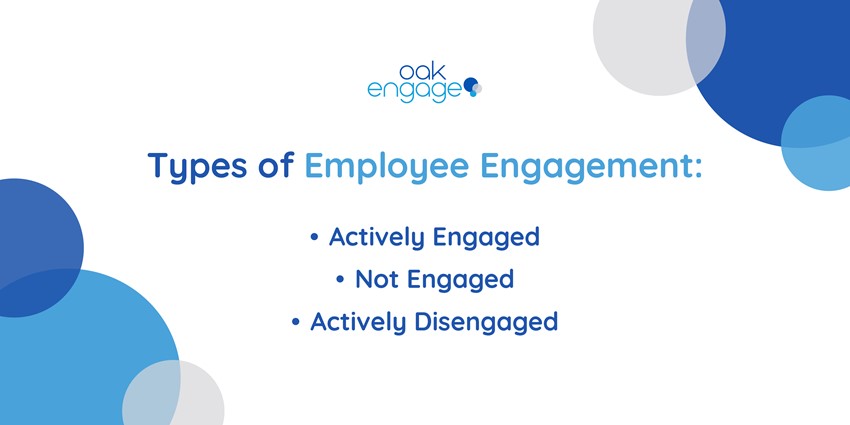
1. Actively Engaged
Actively Engaged employees are passionate about what they do in their role and fully committed to the company mission. These people bring a positive attitude that can trickle down into other departments.
Actively Engaged employees have meaningful relationships and interactions with their colleagues and feel like they are a part of a supportive and close-knit team.
2. Not Engaged
Most employees fall into the middle ground for levels of engagement. They put in their time and fulfill their job responsibilities, but they are more neutral about the company and don’t really put any more effort in than their job description.
This group may just need a reason to be inspired and could become actively engaged with an extra push from managers and leaders.
3. Actively Disengaged
While Actively Disengaged employees are usually the outliers, they can have a big impact on team dynamics. These employees are negative and resentful about the company and are often under-performers.
Actively disengaged employees are likely to be looking for jobs at other organizations and can lead to an impact on a company’s retention rates. Plus, this negative energy can impact morale on various teams, reduce productivity, and cost your company big money.
Drivers of Employee Engagement
There are many drivers of employee engagement that can be considered and easily used to improve employee engagement.
An analysis conducted by The Conference Board identified 26 common drivers of engagement among 12 leading engagement research companies, 8 of which were common to all:
- Trust and integrity - How well do managers communicate?
- Nature of the job - Is it mentally stimulating day-to-day?
- Line of sight between employee performance and company performance - Do employees understand how their work contributes to the company’s performance?
- Career growth opportunities - Are there opportunities for growth within the business?
- Pride about the company -How much self-esteem do the staff feel by being associated with their business?
- Coworkers/team members - How much influence do they exert on the employee’s level of engagement?
- Employee development - Is the company making an effort to develop the employee’s skills?
- Relationship with managers - Does the employee value relationships with managers, and is there trust and credibility?
Who Is Responsible for Employee Engagement?
Ultimately, it comes down to business leaders who are responsible for employee engagement across their organisation. Leaders and management need to be visible and in touch with front line staff. Without effective leadership communication, engagement rates will start to fall.
Not many employees have a relationship with the main board of their organisation, or the CEO, unless you work in a small business. So, the only relationship we formulate with our company is with our direct boss, our peers and our team.
Essentially, the leader has to be able to engage the people they’re leading, and that engagement has to have four sub-components: Trust, clarity of purpose, alignment of systems and unleashing talent.
There’s also a second component to leadership: as a leader, it is really difficult for them to engage if they're not engaged themselves. Anything on the inside eventually manifests itself on the outside.
Employee Engagement Examples in Action
Now you know the drivers of employee engagement and who is responsible for them. Let’s take a look at 5 examples of the key drivers of employee satisfaction, how they correlate with different needs, and what they look like in action.
|
Key Driver of Engagement |
Satisfies This Need |
Effect on Employee Performance |
|
“My company recognises and rewards employees who are doing their jobs well or going above and beyond.” |
Esteem Belonging |
|
|
“There is a strong sense of teamwork and company culture here.” |
Belonging |
|
|
“I feel confident in my job security with this company.” |
Job Safety |
|
|
“My work space is comfortable, and I have the tools and resources I need.” |
Psychological |
|
|
“I am fairly compensated with salary and benefits and work perks.” |
Psychological Esteem |
|
Benefits of Employee Engagement
The benefits of a happy and engaged workforce are endless. Read our 5 benefits of employee engagement that you could start achieving in your company today.
1. Higher Employee Retention
Employee retention is one of the biggest problems that a company has to deal with. The link between employee engagement and retention is well established and employees who are highly engaged are 87% less likely to leave an employer.
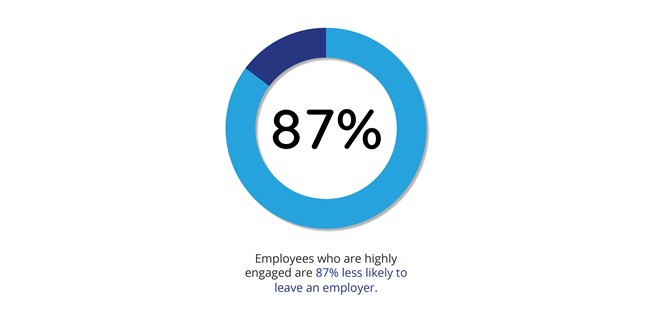
2. Happier Employees
Highly engaged organisations don’t have to resort to things like peer pressure, termination, or other high-stress behaviors to motivate employees. Instead, these organisations use practises like employee recognition, one-on-one meetings, and gathering feedback to drive performance.
3. Improved Employee Satisfaction
Employee satisfaction is different from employee engagement. Employee satisfaction measures a minimum level, while engagement tries to get a whole workforce to achieve greater. However, this difference doesn't mean employee satisfaction shouldn't be a goal.
13% of Americans are somewhat dissatisfied or very dissatisfied with their current job. That wouldn’t be the case if those employees were engaged.
4. Greater Employee Loyalty
Even if an employee isn't looking for a new job, that doesn't mean they won't leave your company if something better came along. However, when employees are engaged, they stick around. Employees are much less likely to leave when they care about the success of the organisation and they are appropriately challenged by their work.
5. Improved Productivity
Research shows that engaged employees are 17% more productive than their peers. Employee productivity is the engine on which a business thrives. The more efficient your workforce is, the more your company will succeed. Productive employees focus on the right things at the right times. There’s very little wasted effort, and the work they do creates the results you want.
Recommended Reading 📖: Employee Engagement Strategy [Examples Included]
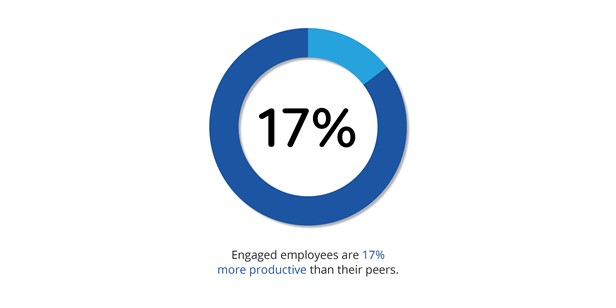
Reasons for Low Employee Engagement
Employee disengagement doesn't happen overnight, it’s a build up of factors that will lead to an employee to become unproductive and unhappy at work. Take a look at some reasons which may cause your employees to become disengaged at work.
Poor Communication
Communication is crucial when it comes to engaging your employees. If management isn't communicating with their workforce and fails to have one-to-one meetings about how well they're performing, it can often lead to miscommunication.
Furthermore, if your company doesn't have an effective means of communication or you're still using email as your main communication method, your employees will struggle to connect with you. At Oak Engage, we provide a tailored intranet to suit your needs, enabling your workforce to connect with any employee, wherever they are.
Lack of Recognition
Employees who feel valued will continue to work hard to impress leadership. Those who are not recognized as a contributor will eventually stop trying. Therefore it’s important to recognise your employees for their contributions and hard work to boost morale.
There are many ways that you can recognise your employees, however having an employee recognition system on your intranet is one of the easiest and most efficient ways to do it. At Oak, our employee recognition feature has an inbuilt timeline, meaning your employees can comment on achievements at any time. This creates a positive working environment, which will in turn, boost morale and improve employee wellbeing.
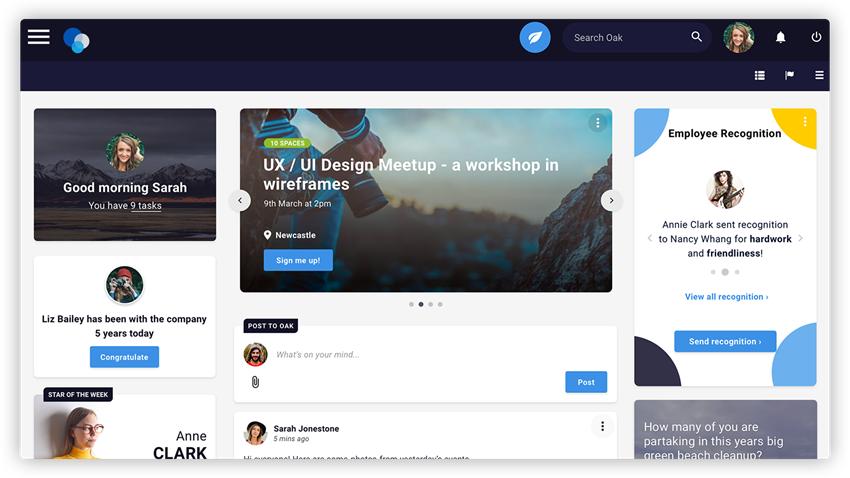
Lack of Collaboration
Teamwork is a huge part of great company culture. In order for a business to grow and be successful, it must value the opportunity for better collaboration. Business collaboration enables businesses to work together to solve problems and achieve their goals to grow.
Oak can help your business improve collaboration across your business by bringing together workforces with social timelines, hubs and a content management system where important company documents can be accessed at any time.
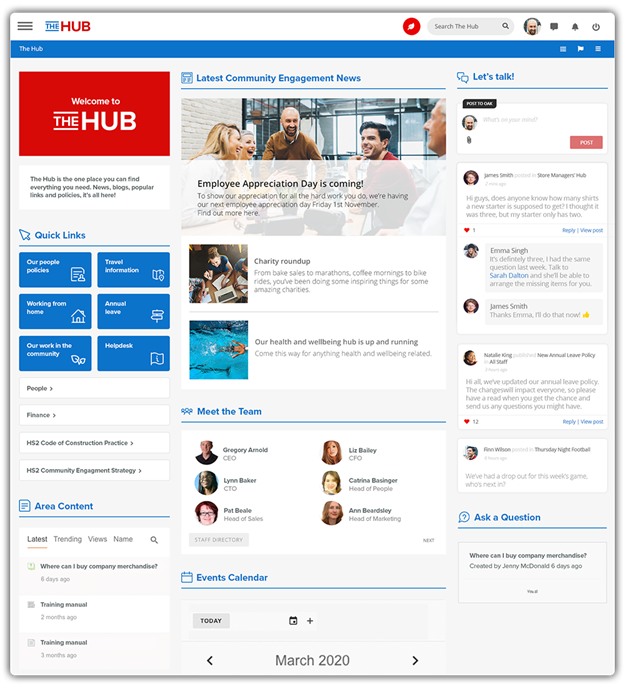
Poor Management
Employees want transparency from their management. This includes having contact with senior leadership, being kept in the loop about future development and goals, and so on.
Having a company intranet will help you to get important company information and announcements out to your employees easily and seamlessly.
Read our Ultimate Intranet Guide for more information on how an intranet can help you address any low engagement factors in the workplace.
How to Increase Employee Engagement
Companies that value their employees will reap the rewards of a dedicated, passionate and skilled workforce. However, those that fail to nurture and reward their staff won’t get the most out of their people, regardless of how talented they might be.
Here are 5 employee engagement ideas you can use to improve employee engagement in your organisation:
- Give feedback and recognition
- Encourage employee interaction
- Improve communication
- Emphasise your company culture
- Focus on employee wellbeing
Recommended Reading 📖
Defining ROI in Today’s Workplace
Of course, employee engagement and wellbeing can help companies yield better financial returns. As you’ve seen in this guide, employee engagement is one of the biggest financial drivers for companies, regardless of size or industry.
Companies with an engaged workforce have reported seeing a significant uplift in the volume and quality in sales: on average 20% higher than those without. With 17% higher productivity and 21% higher profitability than companies without any effective engagement strategies, it’s no wonder that some of the world’s most successful companies are now incorporating employee engagement into part of their wider strategies. Now it’s your turn!
FAQ’s
What is employee engagement?
Employee engagement is the emotional commitment the employee has to their organization and its goals. They don't work just for the pay, but work on behalf of the organization's goals, ultimately creating more success for the company.
Who is responsible for employee engagement?
Leaders and management need to be visible and in touch with front line staff. Without effective leadership, engagement rates will start to fall.
What are the types of employee engagement?
- Actively Engaged
- Not Engaged
- Actively Disengaged
How do you improve employee engagement?
Companies that value their employees will reap the rewards of a dedicated, passionate and skilled workforce. You must put your employees' well being first, emphasising a good company culture.
How do you measure employee engagement?
Measuring employee engagement the right way is often something a lot of companies struggle with.
There are various ways to measure the level of engagement within your company. As a leader you can either:
- Use an employee engagement survey
- Measure employee engagement yourself
- Use a hybrid approach in which annual engagement is measured by the survey provider, while pulse engagement is measured by the company throughout the year.
Learn more about
Improving Employee Engagement >



